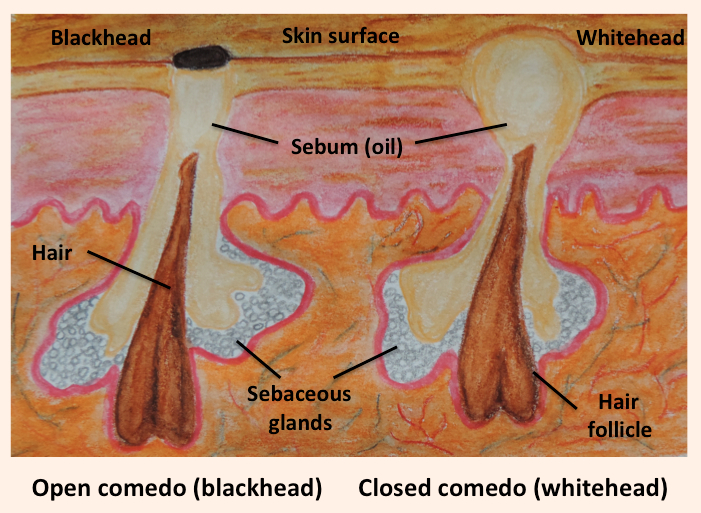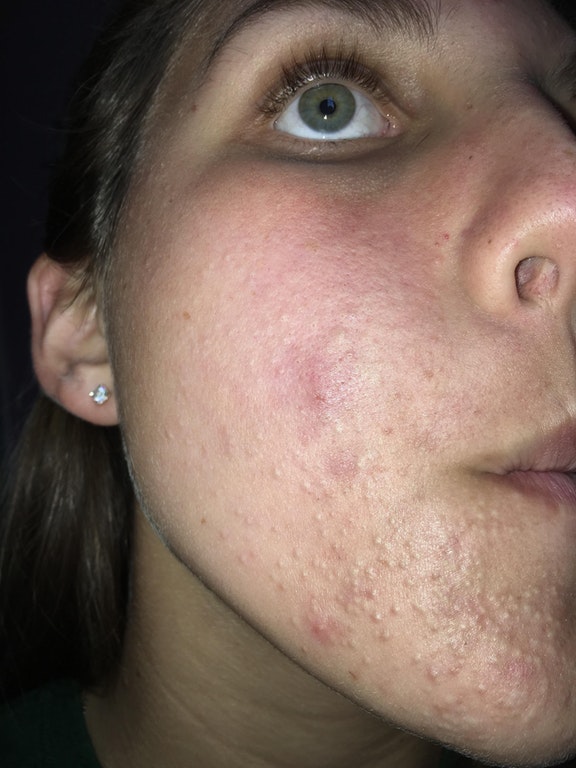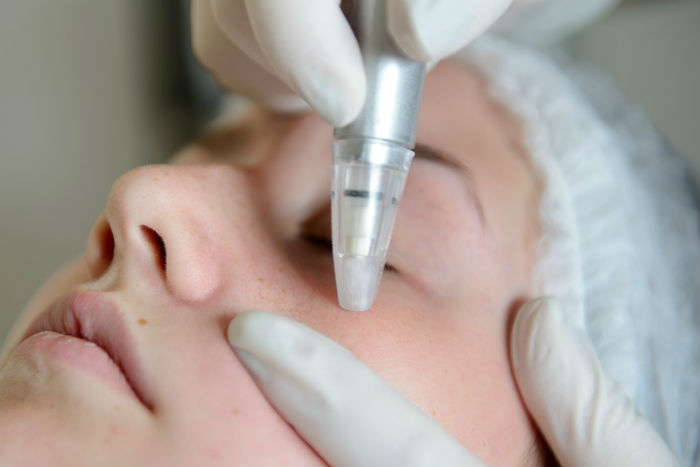Most often acne occurs due to hormonal changes, before the monthly cycle, after the use of certain cosmetics, it may be caused by inappropriate cleaning of the skin and other factors.
As the causes of acne occurrence are numerous, the different types of acne should be well distinguished in order to find the most effective fixing options. Here are the most common types of acne and the impact of microdermabrasion (MDA) procedures on each of them:
Light acne types
The light types of acne are known as comedones or blackheads. They occur when hair follicles are blocked by sebaceous sebum and dead skin cells. There is no redness or soreness, as with some other types of acne.
There are two kinds of comedones
Open comedones
Open comedones are the first type. They occur when the skin secretes sebum, has accumulated dead cells and this mixture is exposed to the air. Oxidation is due to atmospheric air.
Closed comedones
They are characterized by the small white tip that appears beneath the surface of the skin. They appear when the sebum and dead skin cells completely cover the hair follicle. Closed comedones often resemble skin-colored bumps. There is no soreness or redness. They most often appear on the facial area.

Microdermabrasion procedures are very suitable for controlling light acne, as it removes the excess sebum and bacteria, causing pore-clogging and infection.
Moderate acne types
There are two types of acne that are classified as moderate acne:
Papules
These are red pimples on the skin that are rarely raised, do not contain pus or fluid. Sometimes they are accompanied by other symptoms such as itching, mild pain or scaling.
Microdermabrasion can provide beneficial results for moderate acne types. Note, that the side effects (skin sensitivity and redness) may take longer to fade, especially if there is an active infection.
Pustules
Pustules are red swollen buds that contain pus. This thick yellowish or greenish opaque liquid consists of white blood cells, sebum, dead skin cells and bacteria with tissue debris. Pustules are usually preceded by papules. They usually appear on the face and on the back.
Severe types of acne
Conglobal acne
It is characterized by the appearance of large, painful bumps, which are often red. This type of acne is more pronounced in men. Keeping the condition under control is difficult, sometimes serious intervention may be needed and often, after the complete acne removal, permanent scars remain on the skin. It can affect the face, back, chest, and less often the hips. The presence of cysts is also characteristic of this type of acne.
MDA procedures are not recommended for the management of conglobal acne type.
Nodulocystic acne
It occurs, causing deep and inflamed pimples on the facial skin or other areas of the body. Sufferers of this type of acne develop nodules as well as cysts. Fixing these persistent lesions is also difficult and time-consuming. It is more pronounced in teenagers and young men.
Acne can affect adults, as well as babies and young children. The pimples most often appear on the cheekbones. Acne in youngsters may occur after using too oily creams when elevated levels of male sex hormones are present.
Reddit u/eliseb20 tried an MDA procedure with the hopes to eliminate her acne, however, she had active acne lesions.

Microdermabrasion cannot provide a positive effect on the more severe forms of acne. Sometimes, it may additionally irritate the skin.
Benefits Of MDA For Acne and Acne-Prone Skin
Both beauticians and dermatologists resort to microdermabrasion, as this is a gentle, yet effective method to unclog your skin pores. The accumulated bacteria, dirt and other contaminants are the reasons why infections occur, provoking the appearance of acne.
Below you can read about the general benefits MDA procedures provide:
- Boosts blood circulation improving the skin cell function – the improved circulation plays an extremely important role when it comes to acne. Oxygen, minerals, vitamins, hormones and other elements are needed for the proper function of the skin and, above all, for the faster skin cell turnover. When skin cells are supplied by the blood, they are provided with the nutrients needed. The blood flow regulation also leads to removing all waste products and toxins that will eventually cause the premature aging of your skin.
- Enhances product penetration – by opening the pores and removing the dead skin cells and contaminants, you can get more benefits from the skincare products you are using, as they will penetrate deeper into the skin, providing maximum effectiveness.
- Removing blackheads – blackheads are accumulated sebum in the hair follicles that, after oxidation, darken their color. Microdermabrasion removes the excessive sebum by gently exfoliating the outermost skin layer. The next step is the extraction of blackheads – a process that can be easily accomplished with the vacuum feature provided in most MDA devices.
- Reduce pore size – pore shrinking is crucial if you’d like to avoid potential infections or acne. Open pores are usually caused by the natural aging process of the skin but they can reduce in size if they are properly cleaned and debris are removed. Unclogged pores shrink as there are no contaminants holding them open.
- Suitable for men and women – Both men and women can benefit from MDA procedures having that problems, such as enlarged pores, acne, ingrown hairs, rough skin can affect both sexes.
- Safe – This is one of the most important characteristics of microdermabrasion. Compared to other, rather invasive procedures, aiming to treat acne (chemical peels, dermabrasion, etc.), there are no risks, leading to permanent skin damage. The only side effects include increased sensitivity and skin redness that disappear within the next few hours.
- Suitable for different body areas – microdermabrasion can be performed to the facial area, the neck, chest, shoulders, and the back area. These are the most common body parts where acne appears.
- Others – MDA technique will not only help your acne disappear, but it will also make your skin look rejuvenated, it will decrease the number of fine lines and wrinkles, uncovering a fresher skin layer.
Post microdermabrasion breakout
Some users (very few) experience post microdermabrasion breakouts. During the skin cell turnover period, the acne may worsen, as the skin cells excrete the waste products and toxins accumulated. The recovery period usually takes a couple of days, after that you will begin seeing the improvements and your skin will look radiant, softer and blemish-free.
Note that the proper skin cleansing routine (in the morning and just before bedtime) is also important. The facial area should be carefully cleaned before the microdermabrasion procedure as well. This is how you will be able to avoid potential infections during your session. In case you are using a home microdermabrasion device, please make sure that it is carefully disinfected before beginning your procedure.
Is microdermabrasion effective for acne scars, dark marks, and pits?
The main target of microdermabrasion is smoother skin, brighter complexion and improved overall condition of your skin.
Acne scars (depending on the severity of the problem) can be successfully reduced after multiple procedures. By stimulating skin regeneration, collagen and elastin are produced in the skin cells. This results in skin softness and suppleness. Acne scars are harder to treat even after a prolonged period of treatment, as skin integrity is already damaged. Usually, complete removal of acne scars is not possible – the more aggressive methods (such as laser surgeries) will provide more beneficial results. Microdermabrasion will make them less visible, but the deep scars cannot be 100% removed, having that this is a non-invasive method.
Dark spots are easier to treat using microdermabrasion because they don’t affect deeper skin layers. Each subsequent session will make the dark spots lighter until they completely disappear.
How much does microdermabrasion for acne cost?
It depends on the severity of the problem. Usually, a single session a month is enough for users, suffering very light acne, the moderate acne requires regular procedures, performed twice a month for about 6 months until the acne problem is under control.
A single in-office microdermabrasion session costs $200-$300, the visible results will be available after the initial session.
The good news is that there are much cheaper options – at-home microdermabrasion devices that are intended for unlimited MDA procedures. They provide the same effects but you should perform the procedure yourself.
At-home microdermabrasion for fixing acne
This is the most cost-effective option when it comes to microdermabrasion. You can get your own machine for the same price as the single procedure at a beautician’s office ($200-$300), there are even cheaper devices (less than $70). Most users prefer performing microdermabrasion at home, as the procedure guarantees the same results as the professional session. Additionally, it is less time-consuming and such devices can be used whenever you like, as often as you need.
How often should I use my microdermabrasion device?
Microdermabrasion procedures are non-abrasive and non-invasive. Consumers with different skin issues (acne, oily, aging, unevenly pigmented skin, etc.) resort to microdermabrasion so that they can easily improve their skin’ appearance. Sessions can be done as frequently as weekly or up to every 8 weeks depending on your skin’s needs and tolerance.
However, for users with acne or acne-prone skin 1 or 2 sessions per month are sufficient, as these skin problems are often related to increased irritation susceptibility.
References
- About Microdermabrasion Side Effects
https://www.livestrong.com/article/116704-microdermabrasion-side-effects/



